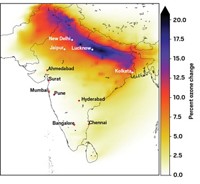Advertisement
Grab your lab coat. Let's get started
Welcome!
Welcome!
Create an account below to get 6 C&EN articles per month, receive newsletters and more - all free.
It seems this is your first time logging in online. Please enter the following information to continue.
As an ACS member you automatically get access to this site. All we need is few more details to create your reading experience.
Not you? Sign in with a different account.
Not you? Sign in with a different account.
ERROR 1
ERROR 1
ERROR 2
ERROR 2
ERROR 2
ERROR 2
ERROR 2
Password and Confirm password must match.
If you have an ACS member number, please enter it here so we can link this account to your membership. (optional)
ERROR 2
ACS values your privacy. By submitting your information, you are gaining access to C&EN and subscribing to our weekly newsletter. We use the information you provide to make your reading experience better, and we will never sell your data to third party members.
Pollution
Restricting NO2 emissions linked with reduction in childhood asthma incidence
Southern California study suggests further emissions cuts would continue to reduce public health burden
by Katherine Bourzac
July 28, 2019
| A version of this story appeared in
Volume 97, Issue 30

Air pollution exacerbates lung conditions, including asthma. Researchers have now added to the evidence that pollution exposure is correlated with onset of the disease in children—and that tighter regulations on one pollutant in particular, nitrogen dioxide, could reduce the incidence of childhood asthma. University of Southern California environmental health researchers led by Kiros Berhane and Erika Garcia drew on 20 years of data from the Southern California Children’s Health Study. In May, the team reported that falling NO2 emissions from 1993 to 2014 were correlated with a 20% decline in the incidence of childhood asthma (JAMA, J. Am. Med. Assoc. 2019, DOI: 10.1001/jama.2019.5357). Garcia says they wanted to provide policy makers with actionable information on the effects of further regulation of emissions, so they used modeling to predict what would have happened if NO2 emissions had dropped even more. The US Environmental Protection Agency limits annual average NO2 levels to 53 ppb; emissions of the gas, which plays a role in ozone formation, are regulated at vehicle tailpipes and from industrial facilities. No child in the study had been exposed to levels greater than 40 ppb, Garcia says. About 22% of the children in the study got asthma; if emissions had been reduced by 20% from those measured in the study, the asthma incidence would have dropped to about 17% (Proc. Natl. Acad. Sci. U.S.A. 2019, DOI: 10.1073/pnas.1815678116).




Join the conversation
Contact the reporter
Submit a Letter to the Editor for publication
Engage with us on Twitter